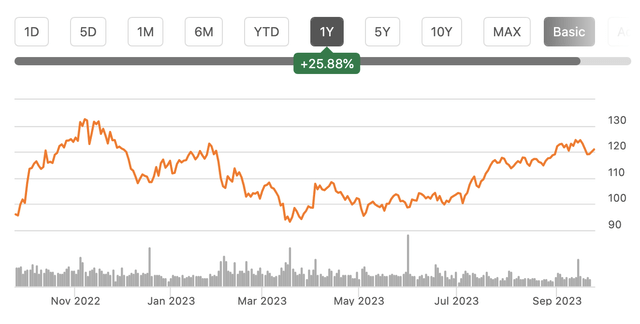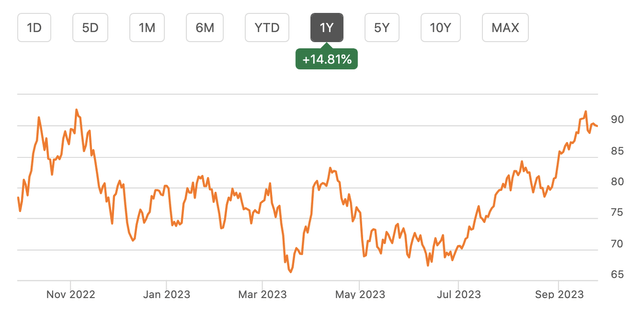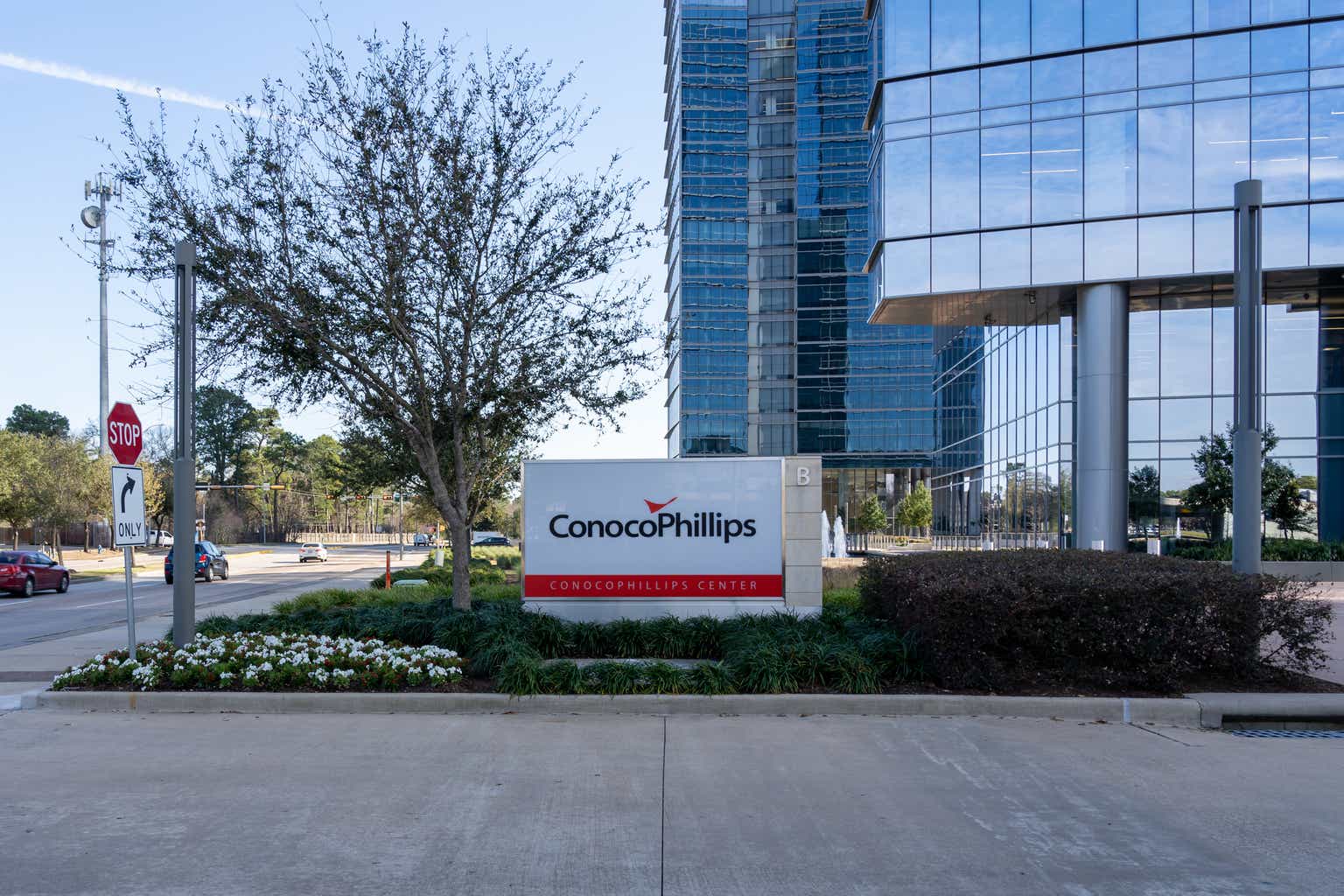Shares of ConocoPhillips (NYSE:COP) have been on a strong run since July, alongside higher crude oil prices. Since I recommended buying shares last October, COP has returned about 11%, including special dividends. However, with strong cash flow, a shrewd acquisition, and favorable commodity prices, I see further upside for shares. I recommend buying here.
Seeking Alpha
In the company’s second quarter, it earned $1.84 in adjusted EPS, which was down from $3.96 last year. This decline was due to lower realizations. In the quarter, Conoco had an average realization of $54.50 with WTI at $74 and Henry Hub natural gas at $2.09. Last year, realizations were over $88 given stronger crude oil and gas prices amid uncertainty over whether Europe could replace Russian exports.
It is also worth noting that crude oil prices were weaker during Q2 than they are today:
Seeking Alpha
This rise in prices should be beneficial to Conoco’s earnings and support a sequential increase in results. Conoco is also quite sensitive to movements in crude oil with each $1 movement in WTI impacting cash flow by about $120 million. With oil $15 higher, that alone is a $0.35-$0.40 tailwind to quarterly earnings. Importantly, while commodity prices are inherently difficult to predict, it has been my view that oil is more likely to trade in the $80-$100 range than $50-70 over sustained periods. First, the Saudis and Russians have cut their output through the end of the year, which is helping to restrict supply and keep the market tight. The odds of recession are also declining, according to economists, which should support demand.
More fundamentally, even amid the “green transition,” the IEA expects demand for oil to rise by 5.5% over the next 5 years due to a growing world economy, and increased demand from emerging economies. With US oil firms spending less on cap-ex and more on shareholder returns, and globally there being more focus on developing renewable capacity than new fossil fuel production, supply is not set to dramatically increase. With ongoing demand growth, that is a recipe for prices to remain above $80 over time in my view. If you disagree and believe oil prices will fall significantly, either because you expect a recession or quicker transition, Conoco, or just about any oil producer stock, is unlikely to be attractive to you. Oil prices are an inherent risk in the sector.
While Conoco cannot control commodity prices, it can control its operations and capital allocation, and management has been doing a strong job. Even with lower oil prices in Q2, it generated $1.8 billion in free cash flow. Free cash flow has been $4.6 billion in the first half of the year, excluding working capital. For the full year, with prices higher in Q3, free cash flow should be at least $11 billion. Management strives to return about half of cash from operations to shareholders and half devoted to cap-ex. It will hit that formula this year with its planned cap-ex spend of $11 billion, leaving that $11 billion in free cash flow for dividends and buybacks.
With this level of cap-ex, it should produce about 1.81mboe/d (1,810,000 barrels of oil equivalents per day), which is up 3.5% from last year. Importantly, management has twice this year raised its production guidance off of that cap-ex spending, speaking to better-than-expected productivity of the capital program. At this level of cap-ex, combined with $9.1 billion in operating and corporate cash costs, total cash expenses are $31 per BOED, or $23 below its Q2 realizations.
With this low level of cash costs, Conoco can generate free cash flow with oil down below $50/barrel, giving it significant resilience during downturns. Moreover, the company has $7.1 billion in cash on the balance sheet and only about $16.5 billion in debt, or about 1.5x free cash flow. Several years of debt repayment from $26 billion in 2016 have left its balance sheet in a strong place. While no oil company will benefit from lower prices, its conservative balance sheet and lean operating expenses make Conoco a company that can be resilient during downturns.
Additionally in May, Conoco announced it was acquiring the remaining 50% stake in Surmont, an oil sands facility, for $3 billion. These projects have much longer operating lives than shale oil, and while operating cash costs are higher, their ongoing cap-ex needs are lower. In fact, assuming WTI stays above $60, it will generate $600 million in free cash flow. At $80 WTI (lower than today’s trading level), incremental free cash flow will approach $1 billion. While oil sands have fallen out of favor due to their carbon intensity, this has allowed Conoco to purchase the asset cheaply. COP is buying the rest of Surmont at 3x free cash flow, when its entire business trades close to 10x free cash flow, making it an extremely accretive acquisition for shareholders.
And ultimately, cash flow and associated capital returns is the leading reason to own Conoco. It aims to return about half of its cash flow to investors, with about half going into dividends and half into buybacks. Thus far in 2023, it has repurchased $3 billion in stock. COP pays a $0.51 baseline dividend and a variable dividend, which has been running at $0.60.
Thanks to these repurchases, the share count is down about 6.5% over the past year, and the combined $1.11 dividend rate provides a 3.4% return, for a 9.9% capital return rate to shareholders. Over the next year, assuming oil above $80 and $1 billion in incremental free cash flow from Surmont, I expect to see dividends rise. COP should be able to generate about $14-15 billion in free cash flow. That $7+ billion to buybacks can reduce its share count by 5%. That would leave capacity for a $1 variable dividend on top of its $0.51 dividend.
With low-single digit production growth and mid-single digit share count reduction, per share growth should be upper single-digits, enabling not only an elevated payout, but a growing one. Right now, COP trades with about a 10% capital return yield. As investors see free cash flow flex higher due to Surmont and higher crude oil prices, alongside ongoing modest production growth, I expect it can trade to an 8% capital return yield or about $150 per share. For now, investors are being paid to wait and should add to COP stock.
Read the full article here












